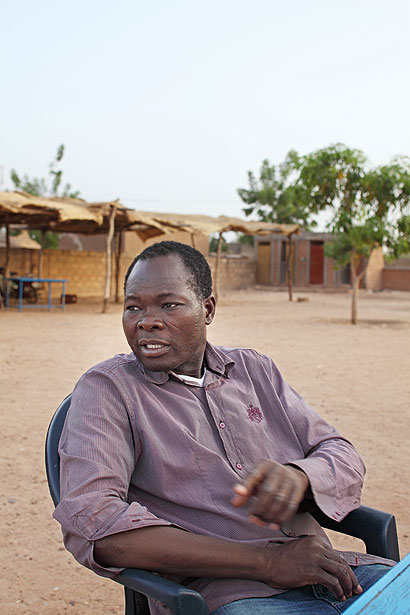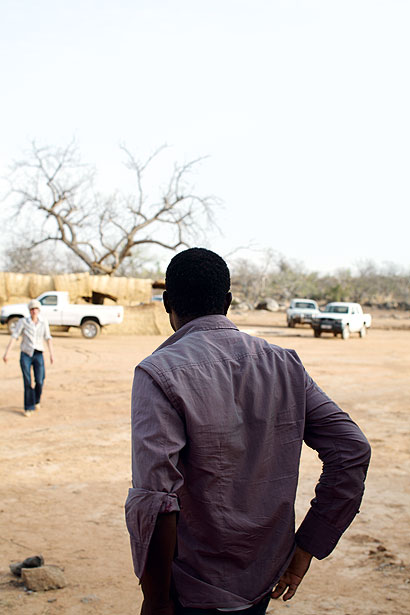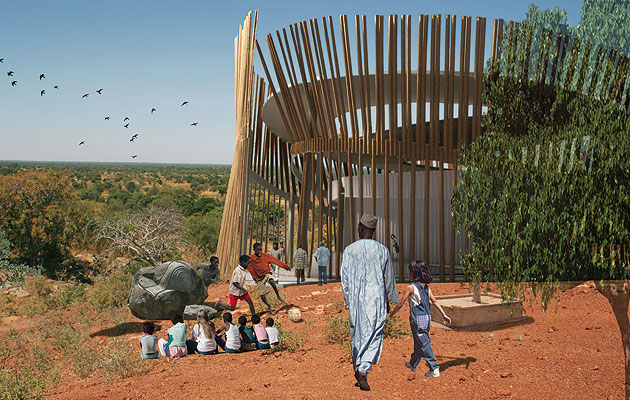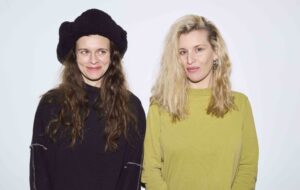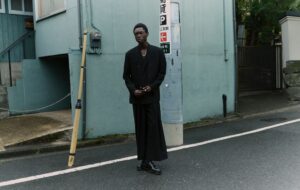|
In Ouagadougou, there is no reply from Francis Kere. The “call me when you get here” system is fallible enough on a trip to the cinema, but worryingly so after a 3,000-mile flight to Burkina Faso. We landed two days ago and have been studiously redialling a number that appears not to work. The stakes this time are a lot higher than at our first, disastrous meeting in London one month ago. At the end of the interview, I looked at my voice recorder and realised that it hadn’t recorded a word. That wasn’t so bad, but the next day the photographer called to say that somehow he had erased all his beautiful portraits from the camera. There was no evidence that the interview had ever happened. So here we are in Ouagadougou. Why go to all this trouble? Because Kéré is an extraordinary architect. Not so much for what he has built – a few school buildings in his native Burkina Faso – but because of what he represents. Born in a remote village, he went on to found a practice in Berlin and win an Aga Khan Award for Architecture. He’s building not just in Africa but in India and Yemen, and he’s so in demand on the lecture circuit that this month alone he’s been invited to Washington, Montreal and Sydney. Africa has precious few spokesmen in architecture – he’s what the world has been waiting for. Kéré has four projects completing this year in Burkina Faso and Mali, but one in particular captures the imagination: an opera village near Ouagadougou. Commissioned by the German artist and director Christoph Schlingensief, the €2 million village will contain a 500-seat performance venue, housing, a school, a hospital and a hotel. It sounds like something from a Werner Herzog movie. In Fitzcarraldo, the mad Klaus Kinski decides to build an opera house in the Amazon jungle. Kéré is building his in the middle of the African savannah. Finally, my phone rings. “I’m in Laongo, come at four o’clock,” says Kéré.
Kéré in an open-air bar on the road into Ouagadougou Laongo is only 40km from Ouagadougou but it might as well be the middle of nowhere. The road there isn’t finished yet. When we get to the site there is not much to see of the opera village except a hole in the ground and three test walls made of earth bricks faced with stone. There is a group in the distance that turns out to be Kéré pursued by a cameraman, a sound technician and two unspecified white women, one of whom is being shaded by an African with a parasol. So you travel thousands of miles, feeling like an intrepid reporter, and what do you find? A German film crew. To make matters worse, the film crew was preceded by two journalists from Brigitte, Germany’s most popular women’s magazine. Apparently they asked moralising questions like “Does Africa really need an opera village?” “I said yes,” says Kéré. “Why else did you come?” To photographer Bas Princen and I, Laongo was an obscure project by a little-known architect. But in Germany it is clearly notorious, while Kéré himself is becoming something of a star. It helps that the “Festspielhaus Africa” was dreamed up by Schlingensief with financial backing from a string of celebrities, including the Hollywood producer Roland Emmerich, the bestselling Swedish crime writer Henning Mankell and the German rock star Herbert Grönemeyer. In June, the German president, Horst Köhler, is planning to visit the site – and the foundations haven’t even been laid yet. Kéré is feeling the pressure. “Unfortunately, or luckily, I am part of this machinery,” he says. “Lots of people in Germany know about this project. There’s too much talk. I don’t like that.” Kéré strides the site pointing to a non-existent school building here and a café there, all of which are supposed to open before the end of the year. “Christoph is a genius but a bit …” says Kéré, tapping his temple. It’s his job to make this vision real, and scattered across the site are the signs of his method. There are piles of freshly cast earth bricks and workers chipping stones for concrete by hand. As far as possible, all the materials will come from the ground itself, while the buildings will negotiate the site without Kéré having to move a single tree. As he talks about it, however, it emerges that the festspielhaus is not an opera house in the Fitzcarraldo sense – it is unlikely that any Verdi will be performed here. Instead, African and global music traditions will come together. It’s a vague explanation, so “opera house” is either a poor translation or an attention-seeking one. Diébédo Francis Kéré, to give him his full name, has tribal scarring around the circumference of his face, and one slash across the cheek. The latter is common in Burkina Faso, but not the former. Kéré is from Gando, 150km from Ouagadougou, where he is the son of the village chief. He left Gando as a boy to become a carpenter, and at 18 won a scholarship to Germany to study woodwork, but later switched to architecture. “As you can see,” he says, “we don’t have wood here.” His first building was a school in Gando, built in 1999 while he was still a student. That school, and an extension from 2007, have only recently started to be published. Kéré, now 39, is suddenly overwhelmed with requests. He was asked to curate the German pavilion at the Venice Biennale this year but he was too busy.
Kéré on site in Laongo, being approached by one of the German television crew At dusk we leave the festspielhaus site and decamp to the Burkinabè equivalent of a biergarten, a sandy roadside lot roamed by chickens, one of which we later eat. Kéré has an entourage consisting of drivers, a few trusted workers and his brother. Throughout the conversation he switches smoothly between English, French and his native language, Mòoré, only resorting to German when he gets stuck. The Mòoré exchanges are always punctuated with laughter. It was clear at the site that Kéré has two roles to play in Africa. There is Francis the European, keeping his German client happy and being their interface with an alien environment. But to the workers he is the motivator and teacher. They look up to him like a king, the African that Europeans travel thousands of miles to visit. As an architect he is also the product of two contexts. In Germany, he says, he learned technique – or perhaps he means the German “technik” – while in Africa he learned how to work with people, above all to be patient with people. I ask whether he thinks he is the only African architect with his global schedule. “I think the first one from real, traditional Africa. Talking not about design but about the people,” he says. Does he not have a peer group? “The problem here is that we don’t have any publications about architecture,” he says. “In the whole of West Africa there is only one architecture school, in Lomé, Togo, and there are less than 200 students. But I am sure that when other Africans get the chance to be trained, they will do what I’m doing – I’m sure.” He wonders what it must be like to have a large practice like Norman Foster or Zaha Hadid. He employs nine people in his Berlin office and that already feels too many. His power is less cumulative than transformative. “You must go to Gando. When you see the context – the landscape and the people – you will understand.” Before dawn, we set off on the two-and-a-half hour drive to Gando. The road from Ouagadougou is like one linear village, but eventually we turn off onto a dirt track and head into open countryside. For many bumpy miles there is nothing except the occasional mud hut with a straw roof, until we reach a grove of neem trees. Kéré’s school buildings emerge unmistakeably from the foliage. Two simple rectangular volumes of reinforced earth bricks with vaulted canopies, and next to them a block of barrel-roofed teacher’s housing. They are somehow a seamless part of this landscape and yet, like Kéré himself, complete exceptions. The rebar space frame holding up the corrugated metal canopies is like rural High Tech. Kéré never mentioned the architectural quality of these buildings. He simply said: “It happened without too much thinking – just making.” Indeed, everything that could be read as beautiful detailing is practical, down to the placement of the windows next to deep pilasters for shade. The canopies themselves keep the sun off and allow hot air to escape through the porous roofs. Some 600 children attend this school, coming either by foot or bike from a 6km radius. Today is Thursday, not a school day, but when I step into one of the classrooms about 40 pupils suddenly stand up. The teacher shares a practical appreciation of the building: “It’s easier to work when everyone’s at ease. If it’s too hot, it’s hard.” Confusingly, there is the sound of raindrops on the canopy, but this is just the metal expanding in the rising heat. Next door some labourers are laying an oval brick wall, the beginnings of what will be the school library. The buildings in Gando were initiated by Kéré himself. Here he plays every role: community activist, fund raiser, architect and builder. Kéré treats the buildings as a form of social empowerment, using local labour and training people who can neither read nor write to translate his drawings into structures. That training is ultimately more valuable than the buildings themselves. In 2004 the first school won the Aga Khan Award for Architecture, and afterwards Kéré became an emissary for the award, scouring Africa for other exemplar projects. “But I stopped doing that,” he says, “because everywhere I went they said give us the tools to make good architecture before coming to ask for good architecture.” Nevertheless, the Aga Khan Development Network recognised Kéré’s rare talent and adopted him as its regional architect. Besides his projects in Burkina Faso, he is developing two sites in Mali for the AKDN, and we went to see them. In the capital, Bamako, Kéré is building a restaurant and sports centre in the Parc National du Mali. In this sprawling, dirty city, the park will be a rare place of leisure, and Kéré’s two buildings are rising steadily out of the red earth. As if the pressure of the festspielhaus weren’t enough, the park has to open in September in time to mark Mali’s 50th anniversary of independence. Meanwhile, an hour’s flight east, in Mopti, Kéré has broken ground on a museum and community centre, also for the AKDN, and also scheduled to complete this year. Looking at the designs of all these buildings, it is clear that they are variations on a single solution, one that combines local materials with technical devices – roof canopies and porous walls – that promote the cooling flow of air. More remarkable than the buildings are the contexts. Even in heaving Bamako, somehow Kéré is building in the rural environment of the botanical gardens, while in Mopti the buildings will overlook the great floodplain. Like the neem grove in Gando, these are magical locations, and Kéré has an intuitive feeling for how to place a building in the landscape. What is refreshing about his projects is that they are not addressing what we in the West perceive as the obvious needs of Africa, say housing in rapidly expanding cities. Whether schools, opera house, museums or restaurants, they are all cultural, as much to do with local pride as basic necessity. In that sense Kéré is a vital bridge between the Africa of charity and the Africa of culture. “I spent all my life building schools and nobody talked about it or came to see them,” says Kéré, so if it takes an opera village to draw the world’s gaze, he implies, then so be it. For his part, he remains modest about his role as Africa’s architectural ambassador. “I’m a technician, maybe a good one, I don’t know.” |
Image Bas Princen
Words Justin McGuirk |
|
|
||
|
A rendering of the performance venue at the Festspielhaus Africa in Laongo |
||

